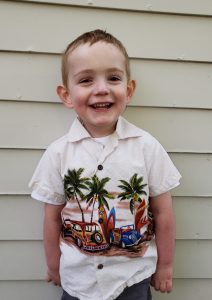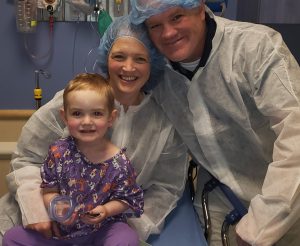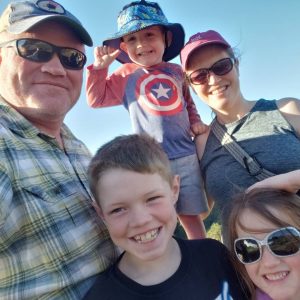Thanks to kids’ cancer research, a little boy named Eli is getting back to a more normal life as a four-year-old.

It was late March of 2017 when Eli’s parents noticed he was having problems with his left arm. Eli, just about two-years-old at the time, was a lively and active boy, always playing with his siblings, so his parents assumed he had a minor injury from everyday play. They followed up with a routine doctor’s checkup for good measure and Eli’s pediatrician thought the same thing. The family went on with day to day life until just a couple of weeks later when it appeared Eli was having trouble turning his neck from left to right. Eli’s parents, Dave and Heather, took him to Children’s Hospital Colorado where a CT scan revealed a mass that spanned from Eli’s brainstem down to his spine.

A few weeks before his birthday, Eli underwent an extremely complex 11-hour surgery where doctors removed all they could of the tumor. Following surgery, Eli couldn’t lift his head or move the left side of his body and it was almost a week before he was able to walk again. Pathology reports indicated the tumor was a juvenile pilocytic astrocytoma (JPA). Eli’s parents were relieved to hear from doctors that Eli’s outlook was positive: he had a “good” type of brain cancer and there was a 90% chance the tumor would not come back.
Six weeks later, their relief turned to anxiety when a follow-up scan showed the tumor had grown by 50 percent forcing Eli’s team to figure out a new roadmap for his treatment. Eli began radiation the next week, enduring 20 treatments over six weeks that required sedation each time. The radiation treatment led to hydrocephalus, the buildup of excess cerebrospinal fluid in the brain, which necessitated an additional surgery to relieve pressure and provide a path for fluid to drain away from Eli’s brain by drilling a small hole in the right side of his skull.

Meanwhile, Eli’s neuro-oncologist, Dr. Nick Foreman, was not satisfied with radiation as the only treatment option, so researchers in the Morgan Adams Foundation Pediatric Brain Tumor Research Program analyzed Eli’s tumor and found that it harbored a rare genetic fusion called FGFR1-TACC1. With that knowledge, researchers then screened Eli’s cells against more than 100 different FDA-approved drugs to determine those that were effective in killing the cancer cells. In the end, trametinib, a MEK-inhibitor typically used for metastatic melanoma in adults, showed the best potential and was selected for Eli’s treatment. Heather calls it a “miracle” drug – because it worked for Eli even though it hadn’t really ever been used in kids before.
Eli’s parents say he’s the toughest kid they know. Even after enduring difficult procedures, Eli was happy and unfazed by the tremendous obstacles presented to him. He is going to preschool regularly, plays soccer, and even learned how to downhill ski last year. On the outside, Eli looks like a normal kid, but his family knows the reality of the deep impact of this disease and how much it affects each of them on a daily basis.

For now, Eli is doing really well. He had good scans in September that showed no change in his brain and spine, so he will be taking a break from the once-a-day trametinib pills and enjoying life as a four-and-a-half-year-old preschooler. Heather and Dave will try to put aside the anxiety in anticipation of his next scan in December. They are incredibly grateful to you for supporting the research that is improving outcomes for kids like Eli and families like theirs who are on this cancer journey.

